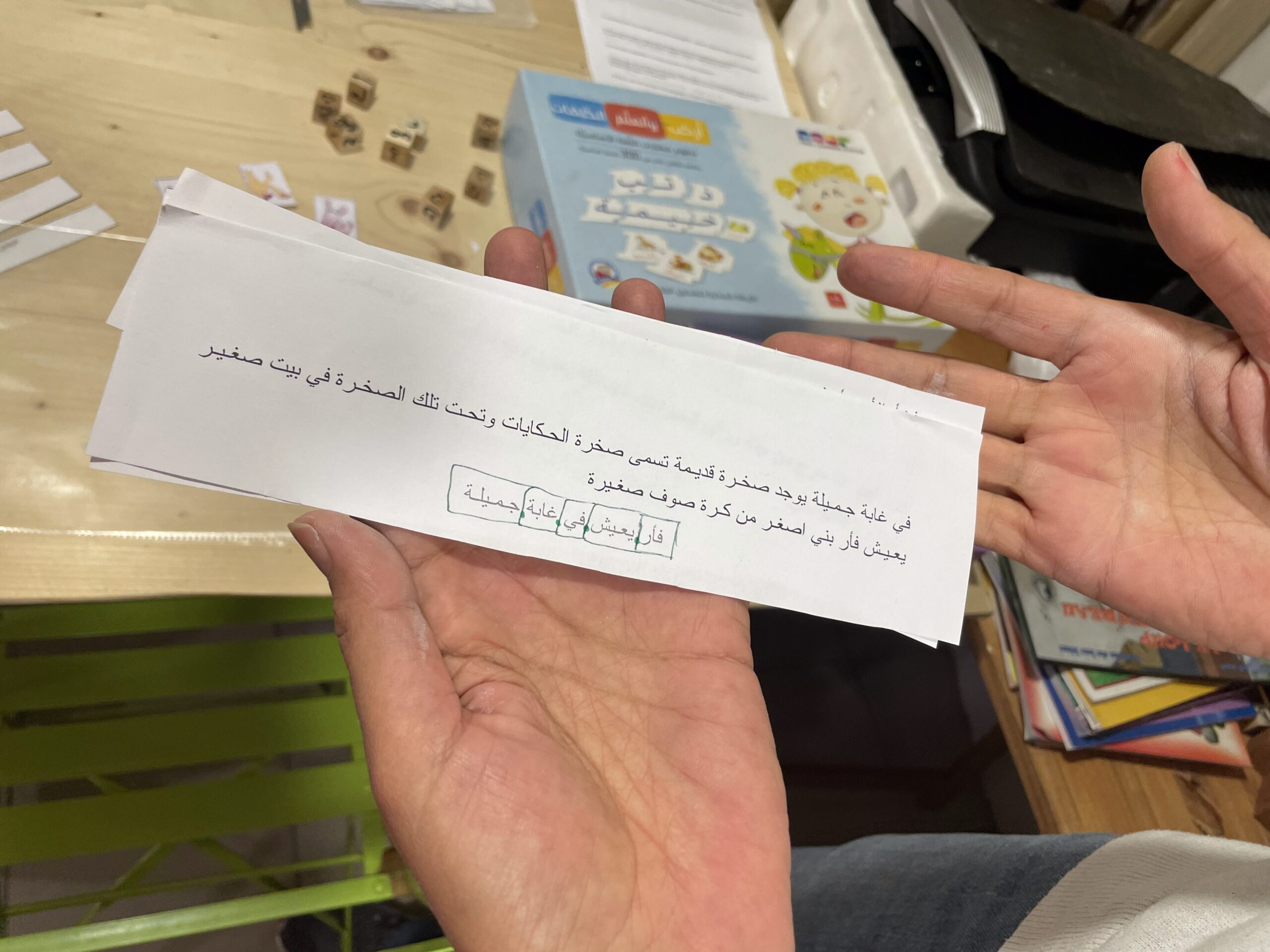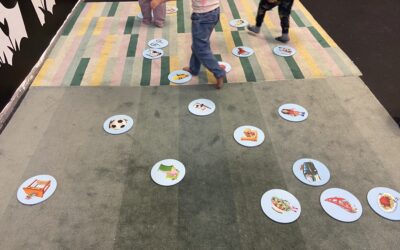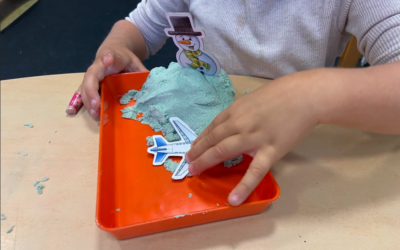Word search game in a story passage
Word search game in a story passage
A fun and educational game that helps children improve reading comprehension and word recognition! Players read a short passage and search for specific words, underlining them with a colored pen. Younger children can form sentences orally, while advanced learners can write sentences using the words they find. Perfect for enhancing vocabulary and literacy skills!
Time
1 hour
4 – 14 years old children
Max 20 Participants
Language skills
Vocabulary Expansion, Reading Comprehension, Word Recognition, Sentence Formation, Spelling Practice
Other skills
Focus & Attention – Searching for words requires concentration, Cognitive Skills critical thinking, Fine Motor Skills, Problem-Solving
Levels
From A1 to A2
None, optionally drawing paper, pens and pencils

Languages Available
- Choose a Story Passage
- Select a short, age-appropriate passage from a story.
- Print or write it clearly on a sheet of paper.
- Read the Story Aloud
- Read the entire story to the child twice.
- Discuss key ideas and ensure they understand the passage.
- Prepare the Activity
- Write an excerpt from the story on a separate sheet of paper.
- Select a few key words from the excerpt (preferably words that can form a sentence).
- Find and Underline the Words
- Ask the child to search for the selected words within the passage.
- Have them underline each word with a different colored pen.
- Copy the Words
- The child writes the underlined words on a separate sheet of paper.
- Sentence Formation Based on Skill Level
- Beginner Level: The child forms a simple oral sentence using the words they found.
- Advanced Level: The child writes a full sentence using the selected words.
This game enhances reading comprehension, vocabulary, spelling, and sentence formation while making learning interactive and fun!

For Educators, Teachers and Parents
In the following section you’ll find additional information to help you adapt this activity for different audiences, language abilities and group sizes. This information should help educators and teachers to adapt the activity to meet the specific needs of different learners and to ensure accessibility, engagement and effectiveness in different learning environments. Optionally, we also give advices to parents how to condct the activity at home.
Challanges
- Memory Limitations
-
- Younger or beginner learners may struggle to remember the full sequence of items, making the game difficult to sustain.
- Some students might lose interest if the list becomes too long or complex.
- Unequal Participation
- More confident or advanced students may dominate the game, while shy or struggling students may hesitate to participate.
- Some students may need extra time to recall items, which can slow down the game.
- Language Barriers
- If the game is played in a second language, some students may not know enough vocabulary to add new items confidently.
- Pronunciation difficulties might make it hard for others to understand repeated words.
- Disruptions and Disengagement
- If the game goes on for too long, students may lose focus or become restless.
- Players who forget an item or make a mistake early on might feel discouraged and disengage.
- Difficulty in Online or Distance Learning
- In virtual settings, lag or connectivity issues can disrupt the flow of the game.
- Without physical interaction, students may find it harder to stay engaged or remember the sequence.
- Managing Large Groups
- With more players, the list of items becomes harder to remember, increasing the chances of mistakes.
- It may be difficult for the teacher to ensure that all students get equal turns
- Enhance Engagement with Challenges
- Set a time limit for finding words to make it more exciting.
- Offer bonus points for forming creative or grammatically complex sentences.
- Encourage Creativity in Sentence Formation
- Allow students to create funny, imaginative, or even story-like sentences with their selected words.
- Provide additional prompts or themes to inspire creativity.
- Provide Feedback and Support
- Offer praise for effort and accuracy.
- Correct mistakes constructively, focusing on learning rather than just right or wrong answers.
- Integrate with Other Language Activities
- Follow up with a writing task where students use the found words in a short paragraph or story.
- Use the activity as a lead-in to spelling practice or grammar lessons.
- Make It Fun!
- Allow students to choose their own colored pens for underlining.
- Turn it into a classroom game by awarding small rewards for participation and effort.
Recommendations for teachers
- Choose Age-Appropriate Texts
Select engaging and level-appropriate stories that match students’ reading abilities.
Use familiar topics to boost interest and comprehension.
- Adapt to Different Skill Levels
- For beginners: Use shorter passages with simple words and encourage oral sentence formation.
- For advanced learners: Choose longer passages with more complex vocabulary and ask them to write sentences.
- For beginners: Use shorter passages with simple words and encourage oral sentence formation.
- Make It Interactive
- Encourage students to read the passage aloud before starting the activity.
- Let them work in pairs or small groups to find words together.
- Incorporate a Discussion Phase
- After underlining words, ask students to explain their meaning or use them in a new context.
- Encourage questions to ensure comprehension.
- Use a Variety of Texts
- Rotate between fiction, non-fiction, poetry, and informational texts. This helps students develop different reading skills and expand their vocabulary
- Adapt to Language Proficiency Levels
- For beginners, allow students to use visual aids or provide a word bank of possible items.
- For more advanced learners, challenge them to add descriptive details about their items (e.g., “I will take a warm, cozy sleeping bag.”).
- Encourage Active Participation
- Use gestures, facial expressions, or real-life objects to engage younger students.
- Allow students to act out or mime their items to make the game more interactive.
- Use Thematic Variations
-
-
- Change the setting of the trip (e.g., a trip to space, a jungle adventure, a visit to a castle).
- Require students to only choose items that start with a specific letter or belong to a certain category (e.g., food, tools, clothing).
- Provide Scaffolding for Struggling Learners
- Write down the list on the board as students add items to help them follow along.
- Repeat the list together as a class before each new turn to reinforce memory.
-
Recommendations parents
- Game Version: To make it more fun, turn the activity into a game where you take turns finding words. Whoever finds a word first gets a point or a small reward.
- Creative Sentence Challenge: Encourage your child to use the found words to create a silly or imaginative story, encouraging creativity and fun with the language.
Adaptation/Application of the method
1. For a Group with Varied Language Proficiency
- Pair or Group Work – Group students by similar skill levels or mix levels for peer support.
- Different Difficulty Levels – Provide simpler or more complex word lists based on each student’s ability.
- Use Visual Aids – Add pictures next to key words for beginner learners.
- Sentence Challenge – Advanced students can create longer or more complex sentences.
- Extra Support – Allow struggling learners to use word banks or dictionaries.
2. For Other Languages
- Use Translated Texts – Provide the same passage in different languages for comparison.
- Language-Specific Word Focus – Choose words that are tricky in pronunciation, grammar, or spelling for that language.
- Phonetic Variations – Highlight differences in pronunciation or script (e.g., Latin vs. Arabic alphabet).
- Cognates & False Friends – Identify words that are similar or different across languages.
3. For Bilingual/Multilingual Options
- Dual-Language Word Search – Have students find and translate words into another language.
- Sentence Formation in Two Languages – Ask students to form sentences in both languages.
- Code-Switching Challenge – Encourage students to mix words from different languages in creative sentences.
- Compare Sentence Structure – Have students analyze how grammar and syntax differ across languages.
4. For Different Cultural Contexts
- Culturally Relevant Texts – Use stories and words that reflect students’ backgrounds and experiences.
- Local vs. Global Variations – Compare how the same words or concepts appear in different cultures.
- Adapt Word Choices – Replace unfamiliar words with culturally relevant equivalents.
- Storytelling Adaptations – Encourage students to write sentences that relate to their own culture.
5. For Other Age Groups
Younger Children (5-7 years)
- Use short, simple sentences with pictures.
- Focus on letter recognition and basic word matching.
- Allow oral responses instead of writing.
Teenagers (15+)
- Use more complex texts, idioms, or abstract concepts.
- Introduce synonyms and antonyms for deeper vocabulary learning.
- Turn the activity into a debate or discussion challenge.
Adults & Language Learners
-
- Use real-world texts (news articles, recipes, instructions).
- Focus on professional or academic vocabulary.
- Encourage sentence writing with context-based meaning.
6.Distant and online learning:
- Use digital Tools for Word Search : Google Docs or Microsoft Word – Share a digital passage where students highlight words instead of underlining them.
- Online Whiteboards (Jamboard, Miro, Padlet) – Students can mark words and write their sentences collaboratively.
- Interactive PDFs or Google Forms – Provide a clickable text where students can select words.
- Educational Apps (Quizlet, Kahoot, Wordwall) – Turn the word search into an interactive game.
- Virtual Story Reading & Discussion: Live Story Reading (Zoom, Teams, Google Meet) – Read the passage aloud and discuss key words.
- Use Pre-Recorded Videos – Share a recorded reading so students can listen at their own pace.
- Audio Versions – Provide an audio file of the passage for listening and pronunciation practice.
- Use Highlighting in Digital Documents – Instead of underlining, students can use the highlight function in shared documents.
- Typing in Chat or Comments – Students can type the selected words in the chat box or comment section.
- Screenshot & Annotate – Students can take a screenshot of the text and mark words using digital annotation tools (Canva, Notability, or MS Paint).
- To Sentence Formation & Writing Adaptations students used Shared Documents for Collaboration – they write their sentences in a shared Google Doc for real-time feedback.
- Voice Notes & Oral Responses – Use WhatsApp, Flipgrid, or Loom for students to record spoken sentences.
- Breakout Rooms for Peer Work – Assign students to virtual rooms to discuss and form sentences together.
- Making It Engaging in an Online Setting by Gamifing the Activity – Use Kahoot, Quizizz, or Wordwall to create interactive word search challenges.
- Leaderboard & Rewards – Track student participation with points, badges, or certificates.
- Discussion Forums (Moodle, Edmodo, Google Classroom) – Encourage students to post sentences and engage in peer review
Recommendations for teachers
- Choose Age-Appropriate Texts
Select engaging and level-appropriate stories that match students’ reading abilities.
Use familiar topics to boost interest and comprehension.
- Adapt to Different Skill Levels
- For beginners: Use shorter passages with simple words and encourage oral sentence formation.
- For advanced learners: Choose longer passages with more complex vocabulary and ask them to write sentences.
- For beginners: Use shorter passages with simple words and encourage oral sentence formation.
- Make It Interactive
- Encourage students to read the passage aloud before starting the activity.
- Let them work in pairs or small groups to find words together.
- Incorporate a Discussion Phase
- After underlining words, ask students to explain their meaning or use them in a new context.
- Encourage questions to ensure comprehension.
- Use a Variety of Texts
- Rotate between fiction, non-fiction, poetry, and informational texts. This helps students develop different reading skills and expand their vocabulary
- Adapt to Language Proficiency Levels
- For beginners, allow students to use visual aids or provide a word bank of possible items.
- For more advanced learners, challenge them to add descriptive details about their items (e.g., “I will take a warm, cozy sleeping bag.”).
- Encourage Active Participation
- Use gestures, facial expressions, or real-life objects to engage younger students.
- Allow students to act out or mime their items to make the game more interactive.
- Use Thematic Variations
-
-
- Change the setting of the trip (e.g., a trip to space, a jungle adventure, a visit to a castle).
- Require students to only choose items that start with a specific letter or belong to a certain category (e.g., food, tools, clothing).
- Provide Scaffolding for Struggling Learners
- Write down the list on the board as students add items to help them follow along.
- Repeat the list together as a class before each new turn to reinforce memory.
-
References and Resources
Arabic Stories for language learners (Bilingual Arabic-English) : https://archive.org/details/arabic-stories-for-language-learners/mode/2up
Arabic Bloom : https://www.youtube.com/@arabicblooms
Word search games in Arabic: https://wordmint.com/categories/arabic-language
Similar Activities
Stop Dance with Pictures
Stop Dance with PicturesThis method integrates movement, music, and language learning...
Sand Storytelling
Sand StorytellingLet children be creative with kinetic sand as they explore textures,...



